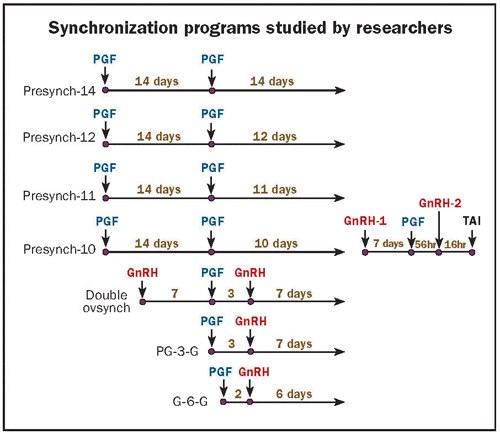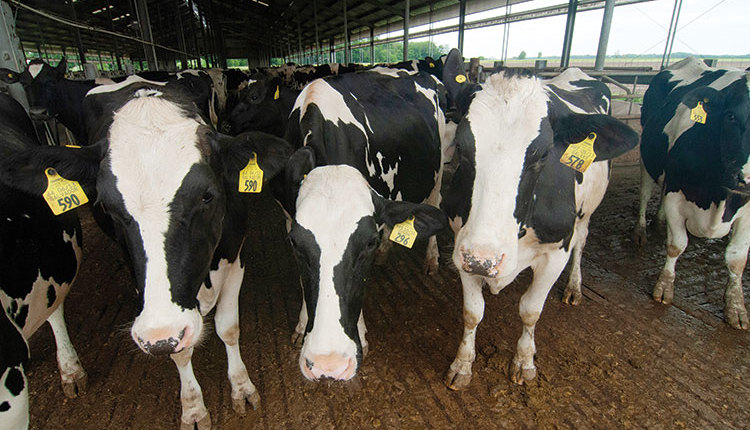The author is professor of animal sciences at Kansas State University, Manhattan.
Probably among the best-known lines in English literature are from William Shakespeare's Hamlet's soliloquy: "To be, or not to be, that is the question." As dairy producers, you probably ask a similar question every day when faced with whether to accept and apply some new technology.
What is the price of change? Will it improve profit? Will it produce more pregnancies?
Since the onset of successful timed A.I. breeding programs in the late 1990s, a number of proven programs have been introduced as viable options to heat-detection-only plans. Let's look at the merits of the most common options used to presynchronize estrous cycles of dairy cows before applying the Ovsynch protocol (see figure at bottom of page).
Some preliminary work at the University of Wisconsin in the late 1990s suggested that cows starting the Ovsynch protocol when on Days 5 to 9 of the estrous cycle had greater ovulatory responses to both the first and second GnRH injection of the Ovsynch protocol. In addition, that research found those cows tended to have greater pregnancy outcomes than cows that started the timed A.I. protocol at other stages of the cycle.
The first presynchronizing option to test that theory was introduced by research led by the University of Florida's Bill Thatcher. Thatcher and his students found that two injections of prostaglandin (PGF) administered 14 days apart and then initiating the Ovsynch protocol 12 days after the second PGF injection (Presynch-12 in figure) produced greater pregnancy rates at first service than cows starting the timed A.I. protocol at random stages of the cycle. Their work was later confirmed by a study we conducted in Kansas.
Changes made
The industry made a number of adaptations to these first studies by then applying Presynch-14 before Ovsynch. Using Presynch-14 before Ovsynch did improve pregnancy rates compared with applying Ovsynch alone based on a North Dakota study. However, researchers found in order to maximize ovulatory responses and subsequent fertility, moving from Presynch-12 to Presynch-14 was not the best thing to do. With Presynch-14, fewer cows are in the ideal 5- to 9-day stage of the cycle than for cows in the Presynch-12 program. Further, a California study showed that pregnancy rates were improved for a Presynch-11 + timed A.I. program compared with a Presynch-14 + timed A.I. program. The table illustrates that more cows are likely to be in the ideal stage of the estrous cycle when the Presynch-11 or Presynch-10 programs are applied before Ovsynch than applying Presynch-14.
Three more recent presynchronizing programs are likely to achieve greater pregnancy rates when applied before Ovsynch. Double Ovsynch and either PG-3-G or G-6-G likely put more cows in the ideal stage of the cycle than either Presynch-14 or Presynch-12 (see table).
These three presynchronizing protocols also take fewer days to set up cows properly than the classic Presynch programs (see table). The PG-3-G program before Ovsynch was tested earlier and found to not improve pregnancy rates compared with Ovsynch in one herd. But our recent studies in Kansas have shown the PG-3-G program to be very effective in boosting ovulation responses and improving pregnancy rates compared with a Presynch-10 program.
The table shows my projections of pregnancy rates achieved at first services in dairy cows based partly on research comparisons and anecdotal testimony of dairy producers. Not all of the presynchronizing protocols before Ovsynch have been compared with cows treated with only the Ovsynch protocol.

Learning more
More recent comparisons, however, of two of the latter three programs (Double Ovsynch and PG-3-G) have been made with Presynch-11 or Presynch-10 before Ovsynch as the control. In both cases, these newer programs seem to outperform the classic Presynch + Ovsynch programs. As we gain greater understanding about how follicles mature and respond to these programs, other systems are likely to be developed.
For example, recent studies published by Jose Santos and his students at the University of Florida illustrated that after applying a Presynch-11 program, reducing the interval between GnRH-1 and PGF of the Ovsynch program in 933 cows from 7 to 5 days resulted in greater pregnancy rates for the 5-day treatment (38 versus 31 percent). All cows were inseminated at 72 hours after PGF, but to make the 5-day program work, a second injection of PGF must be given 24 hours after the traditional PGF injection (48 hours before timed A.I.) to ensure that the CL regresses. Why? When a follicle ovulates after GnRH-1 and forms a new CL in the 5-day program, it requires two PGF injections to destroy the new younger CL.
Many dairy producers already have adapted these programs to reduce costs. Many are inseminating cows observed in heat after the second PGF of the Presynch programs. Some set their voluntary waiting period at 50 days and start the Presynch program at 48 to 50 days so any cow showing good heat activity is submitted for A.I. breeding after either of the Presynch PGF injections.

In some cases, the fertility of these "cherry-picked" cows is as good as those receiving the entire timed A.I. program before first service. In contrast, when the conception rates of these "cherry-picked" cows are not very good, some dairy producers should reconsider the value of breeding these early cows except when good strong heats are detected.
What about your farm?
Examine the evidence in this article and determine if any change is merited for your dairy operation. Change for change sake does not always produce better results. What is designed on paper must be what is actually compliantly done by employees.
The end-user must understand and follow directions. It is much like designing a ration. Is the ration fed to the cows the same one that was designed on paper? If the designed ration results in more milk, then it is successful. If the A.I. breeding program designed on paper actually produces more pregnancies, then it is a success. Execution and compliance to the program are essential to success.
Click here to return to the Reproduction E-Sources
110510_332
Probably among the best-known lines in English literature are from William Shakespeare's Hamlet's soliloquy: "To be, or not to be, that is the question." As dairy producers, you probably ask a similar question every day when faced with whether to accept and apply some new technology.
What is the price of change? Will it improve profit? Will it produce more pregnancies?
Since the onset of successful timed A.I. breeding programs in the late 1990s, a number of proven programs have been introduced as viable options to heat-detection-only plans. Let's look at the merits of the most common options used to presynchronize estrous cycles of dairy cows before applying the Ovsynch protocol (see figure at bottom of page).
Some preliminary work at the University of Wisconsin in the late 1990s suggested that cows starting the Ovsynch protocol when on Days 5 to 9 of the estrous cycle had greater ovulatory responses to both the first and second GnRH injection of the Ovsynch protocol. In addition, that research found those cows tended to have greater pregnancy outcomes than cows that started the timed A.I. protocol at other stages of the cycle.
The first presynchronizing option to test that theory was introduced by research led by the University of Florida's Bill Thatcher. Thatcher and his students found that two injections of prostaglandin (PGF) administered 14 days apart and then initiating the Ovsynch protocol 12 days after the second PGF injection (Presynch-12 in figure) produced greater pregnancy rates at first service than cows starting the timed A.I. protocol at random stages of the cycle. Their work was later confirmed by a study we conducted in Kansas.
Changes made
The industry made a number of adaptations to these first studies by then applying Presynch-14 before Ovsynch. Using Presynch-14 before Ovsynch did improve pregnancy rates compared with applying Ovsynch alone based on a North Dakota study. However, researchers found in order to maximize ovulatory responses and subsequent fertility, moving from Presynch-12 to Presynch-14 was not the best thing to do. With Presynch-14, fewer cows are in the ideal 5- to 9-day stage of the cycle than for cows in the Presynch-12 program. Further, a California study showed that pregnancy rates were improved for a Presynch-11 + timed A.I. program compared with a Presynch-14 + timed A.I. program. The table illustrates that more cows are likely to be in the ideal stage of the estrous cycle when the Presynch-11 or Presynch-10 programs are applied before Ovsynch than applying Presynch-14.
Three more recent presynchronizing programs are likely to achieve greater pregnancy rates when applied before Ovsynch. Double Ovsynch and either PG-3-G or G-6-G likely put more cows in the ideal stage of the cycle than either Presynch-14 or Presynch-12 (see table).
These three presynchronizing protocols also take fewer days to set up cows properly than the classic Presynch programs (see table). The PG-3-G program before Ovsynch was tested earlier and found to not improve pregnancy rates compared with Ovsynch in one herd. But our recent studies in Kansas have shown the PG-3-G program to be very effective in boosting ovulation responses and improving pregnancy rates compared with a Presynch-10 program.
The table shows my projections of pregnancy rates achieved at first services in dairy cows based partly on research comparisons and anecdotal testimony of dairy producers. Not all of the presynchronizing protocols before Ovsynch have been compared with cows treated with only the Ovsynch protocol.

Learning more
More recent comparisons, however, of two of the latter three programs (Double Ovsynch and PG-3-G) have been made with Presynch-11 or Presynch-10 before Ovsynch as the control. In both cases, these newer programs seem to outperform the classic Presynch + Ovsynch programs. As we gain greater understanding about how follicles mature and respond to these programs, other systems are likely to be developed.
For example, recent studies published by Jose Santos and his students at the University of Florida illustrated that after applying a Presynch-11 program, reducing the interval between GnRH-1 and PGF of the Ovsynch program in 933 cows from 7 to 5 days resulted in greater pregnancy rates for the 5-day treatment (38 versus 31 percent). All cows were inseminated at 72 hours after PGF, but to make the 5-day program work, a second injection of PGF must be given 24 hours after the traditional PGF injection (48 hours before timed A.I.) to ensure that the CL regresses. Why? When a follicle ovulates after GnRH-1 and forms a new CL in the 5-day program, it requires two PGF injections to destroy the new younger CL.
Many dairy producers already have adapted these programs to reduce costs. Many are inseminating cows observed in heat after the second PGF of the Presynch programs. Some set their voluntary waiting period at 50 days and start the Presynch program at 48 to 50 days so any cow showing good heat activity is submitted for A.I. breeding after either of the Presynch PGF injections.

In some cases, the fertility of these "cherry-picked" cows is as good as those receiving the entire timed A.I. program before first service. In contrast, when the conception rates of these "cherry-picked" cows are not very good, some dairy producers should reconsider the value of breeding these early cows except when good strong heats are detected.
What about your farm?
Examine the evidence in this article and determine if any change is merited for your dairy operation. Change for change sake does not always produce better results. What is designed on paper must be what is actually compliantly done by employees.
The end-user must understand and follow directions. It is much like designing a ration. Is the ration fed to the cows the same one that was designed on paper? If the designed ration results in more milk, then it is successful. If the A.I. breeding program designed on paper actually produces more pregnancies, then it is a success. Execution and compliance to the program are essential to success.
110510_332










